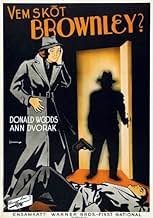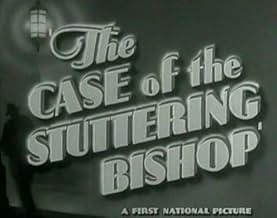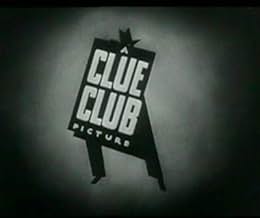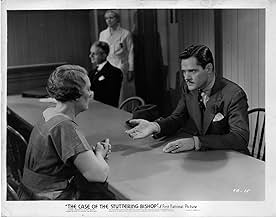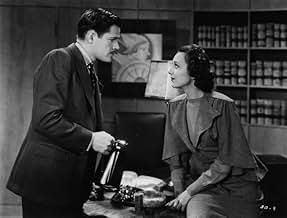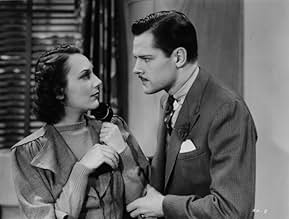Ajouter une intrigue dans votre langueAn improbable stuttering bishop from Australia asks for Perry Mason's help in proving the identity of the legitimate heir to a millionaire.An improbable stuttering bishop from Australia asks for Perry Mason's help in proving the identity of the legitimate heir to a millionaire.An improbable stuttering bishop from Australia asks for Perry Mason's help in proving the identity of the legitimate heir to a millionaire.
- Réalisation
- Scénario
- Casting principal
Helen MacKellar
- Stella Kenwood
- (as Helen McKellar)
Charles C. Wilson
- Hamilton Burger
- (as Charles Wilson)
Eddy Chandler
- Detective James Fleet
- (non crédité)
Avis à la une
Donald Woods stars as Perry Mason in "The Case of the Stuttering Bishop," a 1937 film that also stars Ann Dvorak as a lively Della Street. Frank Faylen is also on hand to pep things up a bit. Both of them are needed, because Donald Woods isn't terribly exciting. Of the men who played Perry Mason in the films, he is perhaps the closest rendering to the actual character. But the book Perry Mason was just that - for books - and it would take Gardner himself to not only choose Raymond Burr (the original Perry Mason was supposed to be Fred MacMurray until Gardner saw Mason at an audition for Hamilton Burger) but oversee the scripts to make the translation to the moving image.
The story concerns a mysterious bishop who asks Perry to help clear a woman accused of manslaughter many years earlier. From there, the story gets into mistaken identity - is a woman posing as an heiress or isn't she - and the solving of a murder. It's a very complicated plot, so pay attention. And Paul Drake is old. If you can sort it all out, you'll find it interesting. There's a little comedy to be had, which is helpful.
I like watching the Perry Mason movies, if only to see the different interpretations of the various roles and the emphasis put into the stories, but in the end, it's best to forget who these characters are supposed to be - because after watching the TV show for years, none of them are. So don't expect much in that department, and you won't be disappointed.
The story concerns a mysterious bishop who asks Perry to help clear a woman accused of manslaughter many years earlier. From there, the story gets into mistaken identity - is a woman posing as an heiress or isn't she - and the solving of a murder. It's a very complicated plot, so pay attention. And Paul Drake is old. If you can sort it all out, you'll find it interesting. There's a little comedy to be had, which is helpful.
I like watching the Perry Mason movies, if only to see the different interpretations of the various roles and the emphasis put into the stories, but in the end, it's best to forget who these characters are supposed to be - because after watching the TV show for years, none of them are. So don't expect much in that department, and you won't be disappointed.
Donald Woods takes over the role of Perry Mason in the last of the Mason series that Warner Brothers did in the 30s with Ann Dvorak as Della Street in
The Case Of The Stuttering Bishop. Erle Stanley Gardner's lawyer/sleuth
would have to wait for television and Raymond Burr for its next incarnation.
Edward McWade, a bishop who stutters comes from Australia to see Woods about a possible fraud being perpetrated on millionaire Gordon Oliver regarding a fake granddaughter being foisted upon him. Later on Myra McKinney, Oliver's estranged daughter-in-law is arrested and it's Perry Mason for the defense.
Hamilton Burger played by Charles Wilson and Joseph Crehan as Paul Drake also appear. Burger for his one and only time in the movie series and Drake is a more traditional private eye. Previously Drake was "Spudsy Drake" played for comic relief by Allen Jenkins in previous films.
Viewers of the classic TV series will note that this observes the Perry Mason paradigm about never having guilty clients and the killer being unmasked in court. Previous films strayed from that somewhat.
I have to mention Tom Kennedy who took a leave from the Torchy Blaine series and brought his usual thick as a brick detective character with him. He's a favorite so incredibly droll and so naive.
Watch it for Tom Kennedy alone.
Edward McWade, a bishop who stutters comes from Australia to see Woods about a possible fraud being perpetrated on millionaire Gordon Oliver regarding a fake granddaughter being foisted upon him. Later on Myra McKinney, Oliver's estranged daughter-in-law is arrested and it's Perry Mason for the defense.
Hamilton Burger played by Charles Wilson and Joseph Crehan as Paul Drake also appear. Burger for his one and only time in the movie series and Drake is a more traditional private eye. Previously Drake was "Spudsy Drake" played for comic relief by Allen Jenkins in previous films.
Viewers of the classic TV series will note that this observes the Perry Mason paradigm about never having guilty clients and the killer being unmasked in court. Previous films strayed from that somewhat.
I have to mention Tom Kennedy who took a leave from the Torchy Blaine series and brought his usual thick as a brick detective character with him. He's a favorite so incredibly droll and so naive.
Watch it for Tom Kennedy alone.
The Perry Mason series of mysteries from the 1930s are some of the best mysteries one could watch. One needs to pay attention to details throughout the film to follow the twists in the plot, which in this movie is very complicated. The movies closely follow the Erle Stanley Gardner mystery novels on which they are based. The Case of the Stuttering Bishop holds one's interest from beginning to end as Perry Mason cleverly addresses the case of a murder committed over a will, inheritance and the fraudulent identity of a key player. Donald Woods does not play the role of Perry Mason as well as Warren William did in this series. William plays the role with panache and wit, whereas Donald Woods plays the role straightforward with no flair—serviceable but not exciting. Ann Dvorak plays the role of Della Street straightforward also with none of the sassiness and cuteness of Genevieve Tobin and none of the glamour and screen presence of Helen Trehnolme in other movies in the series. If you are a fan of old, intriguing mysteries, you won't be disappointed with this gem.
Case of the Stuttering Bishop, The (1937)
** 1/2 (out of 4)
Sixth and final film in Warner's Perry Mason series features a new guy in the lead role but the film turns out to be a rather entertaining entry. This time out, Perry Mason (Donald Woods) is visited by a bishop who asks him to investigate a manslaughter that happened twenty-two years earlier but the guilty party is still free. Perry starts to investigate, which leads him to a billionaire who eventually winds up dead and it seems the same person is behind the two cases. This is a pretty strong film that manages to be quite entertaining, although it would have benefited by a stronger supporting cast. Woods is actually very good in the role of Mason and brings his own charm and brains to the role. Ann Dvorak is entertaining as his secretary but the rest of the cast is so-so at best. The case is actually very well written and manages to be quite complicated, which ruins the ending when we get the typical easy way out and that's the guilty person getting away with it until they break down and admit everything.
** 1/2 (out of 4)
Sixth and final film in Warner's Perry Mason series features a new guy in the lead role but the film turns out to be a rather entertaining entry. This time out, Perry Mason (Donald Woods) is visited by a bishop who asks him to investigate a manslaughter that happened twenty-two years earlier but the guilty party is still free. Perry starts to investigate, which leads him to a billionaire who eventually winds up dead and it seems the same person is behind the two cases. This is a pretty strong film that manages to be quite entertaining, although it would have benefited by a stronger supporting cast. Woods is actually very good in the role of Mason and brings his own charm and brains to the role. Ann Dvorak is entertaining as his secretary but the rest of the cast is so-so at best. The case is actually very well written and manages to be quite complicated, which ruins the ending when we get the typical easy way out and that's the guilty person getting away with it until they break down and admit everything.
We had two great evolutionary paths in the 30s. One was an amazing diversity of invention to settle some basic narrative devices that have since served us well as the basic vocabulary of cinema. The other, parallel path was the pulp detective novel, a master of which was Gardner.
The traditional, Holmes form is that you are linked to the detective. You discover what he does. Christie followed this form, but it is difficult to render in film. Gardner may be the first case — since common — of the novel adopting cinematic form. His formula does seem friendly to film: we see events that Mason does not, often before he gets seriously engaged. These events give us a false impression of what happened, so we as viewers start out with a deficit.
Then we have the detection; Mason and company are detectives in act two. The third act is always a courtroom, which is why our detective has to be a lawyer. Courtroom conventions have their own evolution in film, and this instance is limited to what in Christie's stories has to be a contrived assembly of the suspects.
This format allows for more complicated mysteries than were usual in film. My own preference for 30's detection is Philo Vance because the formula was not so strict. But this is a good one in terms of allowing complexity and surprise. We have that here in this solid instance.
One of the decisions in defining the characters is how intimate to make the relationship between alpha male Mason and his pretty and competent secretary. Why this matters has to do, as Mason would say, with motive. We like the guy. He is smart, as smart as other detectives, but why he does what he does
In some renderings of the Mason format, he just likes to win. He has his own Lestrade who he likes humiliating. Justice is incidental, and truth merely a tactic. He just like to strut.
In other renderings, he does what he does because he loves his team, his closest friend Drake and his lover Della. Both are profoundly loyal and true. He struts for her and we imagine passion after the obligatory Italian restaurant scene.
Here, a delicate balance between the two is maintained.
The traditional, Holmes form is that you are linked to the detective. You discover what he does. Christie followed this form, but it is difficult to render in film. Gardner may be the first case — since common — of the novel adopting cinematic form. His formula does seem friendly to film: we see events that Mason does not, often before he gets seriously engaged. These events give us a false impression of what happened, so we as viewers start out with a deficit.
Then we have the detection; Mason and company are detectives in act two. The third act is always a courtroom, which is why our detective has to be a lawyer. Courtroom conventions have their own evolution in film, and this instance is limited to what in Christie's stories has to be a contrived assembly of the suspects.
This format allows for more complicated mysteries than were usual in film. My own preference for 30's detection is Philo Vance because the formula was not so strict. But this is a good one in terms of allowing complexity and surprise. We have that here in this solid instance.
One of the decisions in defining the characters is how intimate to make the relationship between alpha male Mason and his pretty and competent secretary. Why this matters has to do, as Mason would say, with motive. We like the guy. He is smart, as smart as other detectives, but why he does what he does
In some renderings of the Mason format, he just likes to win. He has his own Lestrade who he likes humiliating. Justice is incidental, and truth merely a tactic. He just like to strut.
In other renderings, he does what he does because he loves his team, his closest friend Drake and his lover Della. Both are profoundly loyal and true. He struts for her and we imagine passion after the obligatory Italian restaurant scene.
Here, a delicate balance between the two is maintained.
Le saviez-vous
- AnecdotesAuthor Erle Stanley Gardner objected so vehemently to what he felt was the miscasting of Ricardo Cortez as Mason, that Warners replaced him with Donald Woods.
- GaffesNear the end, when Mason and his crew are having lunch during a court recess, Della drops her fork on her plate and reaches out across the table to break off some bread (after giving Mason the inadvertent hunch about Stella Kenwood). When the camera cuts back to Mason, Della has fork in hand again, but not the bread.
- Citations
Perry Mason: [to Della] Bishops don't often need lawyers. Show him in.
- ConnexionsFeatured in Le grand sommeil (1946)
- Bandes originalesWhen Irish Eyes Are Smiling
(1912) (uncredited)
Music by Ernest Ball
Lyrics by Chauncey Olcott and George Graff
Sung a cappella with a phony Irish brogue by Donald Woods
Meilleurs choix
Connectez-vous pour évaluer et suivre la liste de favoris afin de recevoir des recommandations personnalisées
Détails
- Date de sortie
- Pays d’origine
- Langue
- Aussi connu sous le nom de
- Clue Club #10: The Case of the Stuttering Bishop
- Lieux de tournage
- Société de production
- Voir plus de crédits d'entreprise sur IMDbPro
- Durée
- 1h 10min(70 min)
- Couleur
- Mixage
- Rapport de forme
- 1.37 : 1
Contribuer à cette page
Suggérer une modification ou ajouter du contenu manquant

